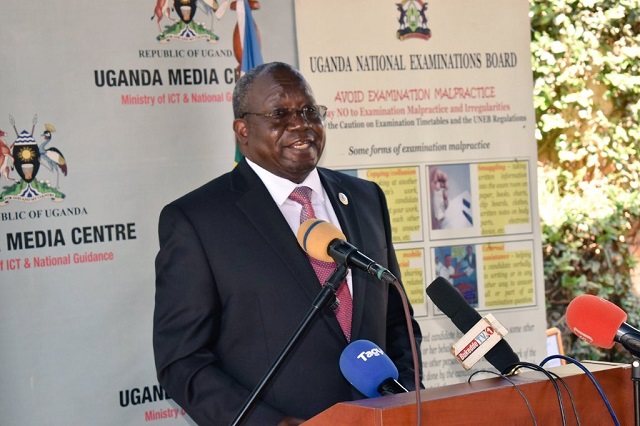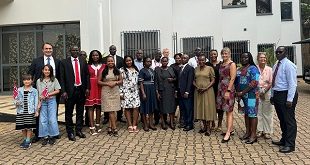
Kampala, Uganda | THE INDEPENDENT | The Uganda National Examination Board (UNEB) has overhauled its assessment approach, shifting towards competency-based evaluation required under the new lower secondary curriculum.
Upon examining the sample papers released on Monday and comparing them with past papers, it’s evident that UNEB has implemented significant changes.
One notable adjustment is the reduction in the number of questions per paper, accompanied by an extension of time for certain subjects. For instance, in Mathematics Paper One, which previously featured 10 questions in section A and eight in section B, there are now six scenarios.
The format and language of questions have also undergone alterations. In many papers, there will now typically be two sections. The first section presents a scenario that learners read and later address through questions labeled as “items.”
Furthermore, objective questions, commonly in subjects like Chemistry, Physics, Biology, Agriculture and Geography, have been eliminated based on the sample papers.
When examining subjects like Chemistry, it becomes apparent that there has been a significant restructuring of examination papers. Previously, there were four papers, two of which focused on practicals. However, the offering has indeed been streamlined to three papers, where each learner must sit for two of them: Paper One and either Paper Two or Paper Three. Other subjects have also merged some of their papers to reduce the number of papers set per subject.
In the past, Chemistry Paper One featured an objective format consisting of 50 questions, requiring learners to select correct answers. However, this format has been scrapped. The new Paper One adopts a competency-based assessment approach. In this revised format, learners are presented with scenarios and tasked with demonstrating their understanding by responding to specific prompts and the time allocated has been increased from one and a half hours to two hours.
A sample item from the new format is as follows: Onyera, living in an area where they use borehole water, slid, fell and his white shirt became dirty. He decided to use a detergent to clean his shirt. The shirt remained with some brown spots yet he had rinsed it several times. From the scenario, learners are prompted to identify the mistake Onyera made in selecting a cleaning product.
They are also required to assist Onyera in comprehending how the chosen product functions. Even in subjects like mathematics, there has been a departure from traditional direct questioning toward competency-based assessments. Instead of merely solving equations or giving straightforward answers, learners are now presented with longer text scenarios that demand careful reading and thoughtful responses.
This new approach aims to evaluate not only the learner’s mathematical calculation skills but also their capability to analyze and apply mathematical concepts in practical scenarios. Through handling scenario-based questions, learners are prompted to think critically and exhibit a more profound comprehension of mathematical principles within real-world contexts.
Joseph Musaazi, a mathematics and physics teacher at Archbishop Kiwanuka SS in Masala City, says the new assessment system is beneficial because it focuses on students’ understanding rather than cram work.
“The previous assessments encouraged memorization,” Musaazi explained to our reporter adding; “But with the competence-based assessment, questions are designed to test how well students can apply what they know and questions from one scenario can cover various topics within one scenario. this will help learners to appreciate how each topic relates to the other.”
Musaazi also noted that previously math exams didn’t assess skills like comprehension because questions were too straightforward. Now, with scenarios, students must understand and apply their knowledge to solve problems.
“For physics questions still require practical understanding, which aligns with effective teaching and learning,” Musaazi continued. He supports the idea of not providing procedures in practical papers. as students are required to explain the procedures they used to reach their solutions.
However, Musaazi acknowledged that schools without proper laboratories and equipment would face difficulties. He emphasized the importance of hands-on, learner-centered teaching in all subjects.
Lydia Nabukeera, an English teacher, mentioned that she had only seen one English paper by the time of the interview. She noted that the paper she had seen focused on functional writing and included a few comprehension questions.
“Previously, comprehension questions were in paper two, which also assessed grammar,” she explained. “Since I haven’t seen paper two yet, I’m not sure if English will have one paper or two.”
Geoffrey Nyende, the Deputy Headteacher in charge of academics at Kololo secondary school, mentioned that while they are still analyzing the sample papers, a brief review suggests that the new assessment demands critical thinking from students before answering any question. Nyende added that the format and structure of the questions will discourage rote learning, which has been prevalent in past assessments.
Nyende added that given that most questions now require comprehension skills in all subjects, emphasizing the teaching of English as a language will be crucial. This means that not only will students need to understand the subject matter, but they must also comprehend the questions being asked.
“This underscores the importance of improving English language proficiency across the board to ensure students can effectively engage with and excel in the new assessment format,” he added.
Aisha Namusoke, a senior four student had not seen the sample papers, but she was eagerly anticipating them. “Since senior one, we have been wondering how the questions will look. Actually, even our teachers had no clue. Last year, Wakissha (Association for Schools in Wakiso District) brought some papers which we did, and I wonder whether their format is the same as these ones,” Namusoke noted.
Doom for deaf students?
Meanwhile, while many teachers have praised the new assessment system, there are concerns that it doesn’t consider the needs of deaf students. A teacher from Wakiso Deaf School, who preferred to remain anonymous, expressed worry about the impact on deaf students.
“Deaf students have unique challenges as their grasp of the English language is limited, and now most questions are wordy,” the teacher explained. “I fear that without special assessments tailored for deaf students, failure rates will increase.”
The teacher noted that previously, deaf students excelled in math because it relied less on English language comprehension. However, the teacher observed that even math papers now contain an excessive amount of text, which could pose difficulties for deaf students.
Examining the sign language sample paper can provide insight into what the teacher is describing. For example, a statement from the Ugandan Sign Language paper reads: “GIRL +++ UNIFORM WEAR-DRESSED SMART WHY.” “Now, how can a student who understands English like that be expected to read longer passages written in normal English?” a teacher questioned.
Teachers continue to analyze the sample papers.
Meanwhile, at some schools in Kampala, which our reporter visited on Tuesday morning, teachers could be seen sitting in groups, earnestly studying the sample papers. Many refrained from commenting on the items, indicating that they were still analyzing them.
However, at one school visited by the reporter, teachers had not yet seen the sample papers. A few they were discussing had been shared with them from other schools.
On Monday, UNEB noted that all sample papers and scoring guides were uploaded on the UNEB portal for schools with centers. They promised that soon, they would distribute hard copies to all schools to ensure even those without centers receive the items.
******
URN
 The Independent Uganda: You get the Truth we Pay the Price
The Independent Uganda: You get the Truth we Pay the Price



Send me samples of the questions on my email
https://uneb.ac.ug/2024/03/26/nlsc_sample_papers/ That is the official link
shillahaugust@gmail.com